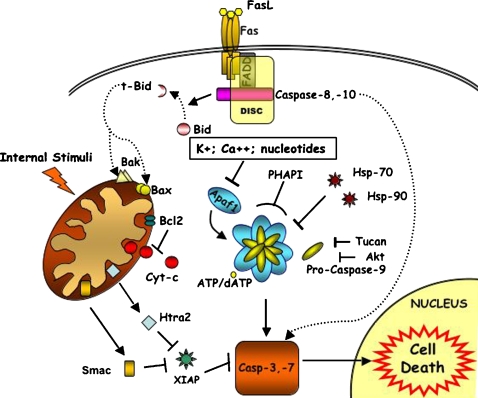Fig. 1.
Apoptosis signalling pathways. Two important pathways of caspase activation exist in mammalian cells, one involving death receptor and the other involving mitochondria (see also text); (→ activation; ⊣ inhibition). The extrinsic cell death pathway (dotted line) is mediated by death receptors (the best studied death receptor is Fas).The binding of Fas ligand (FasL) leads to receptor activation. The Fas receptor contains a death domain (DD) in its cytoplasmic region which interacts with the adaptor protein (FADD), forming the DISC (Death-Inducing Signalling Complex). DISC formation results in the activation of caspase-8,-10 which in turn will activate downstream effector caspase (caspase-3,-7). In the mitochondrial pathway (continuous line), which is initiated by multiple forms of cellular stress, Bax and Bak are activated at mitochondria. Also, Bid (activated by caspase-8 cleaveage in extrinsic cell death pathway) activates Bax and Bak to mediate the release of cytochrome c in the cytosol. Cytochrome c and dATP trigger the assembly of the Apaf1-apoptosome, which recruits and activates caspase-9. This, in turn, cleaves and activates caspase-3. The activation of caspase-3, -7 is antagonized by IAPs, which in turn can be inhibited by Smac/DIABLO and Omi/HtrA2.

